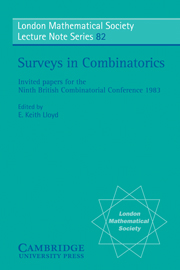Book contents
- Frontmatter
- Contents
- PREFACE
- GRAPHS AND INTERCONNECTION NETWORKS: DIAMETER AND VULNERABILITY
- THE FRIENDSHIP THEOREM AND THE LOVE PROBLEM
- MAXIMUM SETS IN FINITE PROJECTIVE SPACES
- QUASIGROUP IDENTITIES AND ORTHOGONAL ARRAYS
- BOUNDS ON PERMANENTS, AND THE NUMBER OF 1-FACTORS AND 1-FACTORIZATIONS OF BIPARTITE GRAPHS
- REDFIELD DISCOVERED AGAIN
- CHARACTERIZATIONS OF THE LIE INCIDENCE GEOMETRIES
- GL(n, C) FOR COMBINATORIALISTS
- IRREGULARITIES OF PARTITIONS: RAMSEY THEORY, UNIFORM DISTRIBUTION
- INDEX OF NAMES
- SUBJECT INDEX
THE FRIENDSHIP THEOREM AND THE LOVE PROBLEM
Published online by Cambridge University Press: 05 May 2013
- Frontmatter
- Contents
- PREFACE
- GRAPHS AND INTERCONNECTION NETWORKS: DIAMETER AND VULNERABILITY
- THE FRIENDSHIP THEOREM AND THE LOVE PROBLEM
- MAXIMUM SETS IN FINITE PROJECTIVE SPACES
- QUASIGROUP IDENTITIES AND ORTHOGONAL ARRAYS
- BOUNDS ON PERMANENTS, AND THE NUMBER OF 1-FACTORS AND 1-FACTORIZATIONS OF BIPARTITE GRAPHS
- REDFIELD DISCOVERED AGAIN
- CHARACTERIZATIONS OF THE LIE INCIDENCE GEOMETRIES
- GL(n, C) FOR COMBINATORIALISTS
- IRREGULARITIES OF PARTITIONS: RAMSEY THEORY, UNIFORM DISTRIBUTION
- INDEX OF NAMES
- SUBJECT INDEX
Summary
“The nymph Echo fell in love with Narcissus, but was repulsed. Aphrodite punished him for his cruelty by making him enamoured of his own image in a fountain. His fruitless attempts to approach this beautiful object led to his despair and death. He was changed into the flower that bears his name.”
— Sir Paul Harvey, Oxford Companion to Classical Literature.Community relations
In response to the editor's request for a survey article on a combinatorial topic, I have assembled under a single heading —the love problem, as I shall call it — material that has previously appeared in separate contexts and diverse guises, such as the solubility of Diophantine quadratic matrix equations, the construction of block designs, the existence of finite geometries, etc. However, I shall only mention a handful of references as leads into the extensive literature, which I could not hope to cover by anything approaching a complete bibliography. Moreover, in stressing the graph-theoretic aspects of the matter, I shall be adopting a rather different line from traditional treatments.
Let us begin with a special case of the love problem, known as the friendship theorem. I do not know who first stated this theorem: the earliest published paper that I have come across is Wilf (1971), who cites an earlier unpublished account by Graham Higman in 1968.
Information
- Type
- Chapter
- Information
- Surveys in CombinatoricsInvited Papers for the Ninth British Combinatorial Conference 1983, pp. 31 - 54Publisher: Cambridge University PressPrint publication year: 1983
Accessibility standard: Unknown
Why this information is here
This section outlines the accessibility features of this content - including support for screen readers, full keyboard navigation and high-contrast display options. This may not be relevant for you.Accessibility Information
- 1
- Cited by
